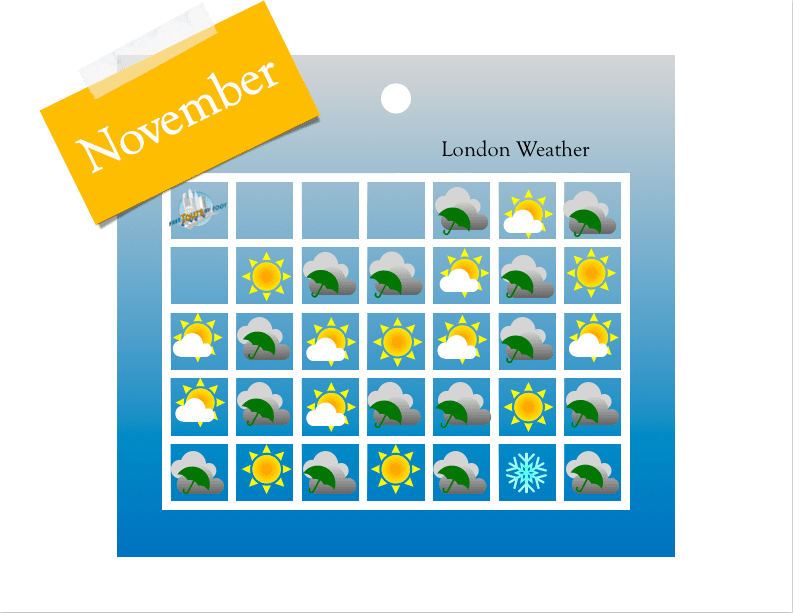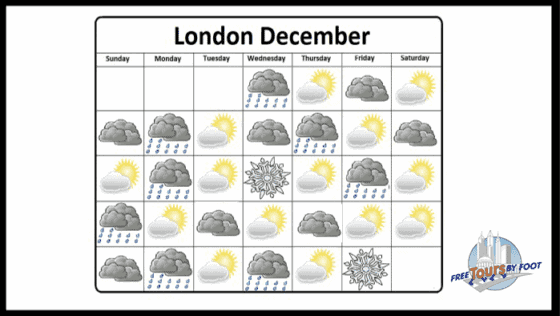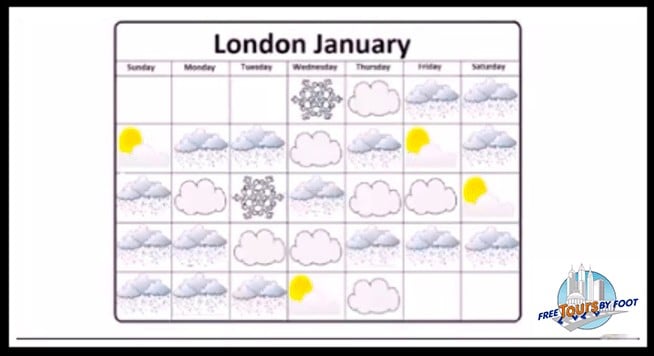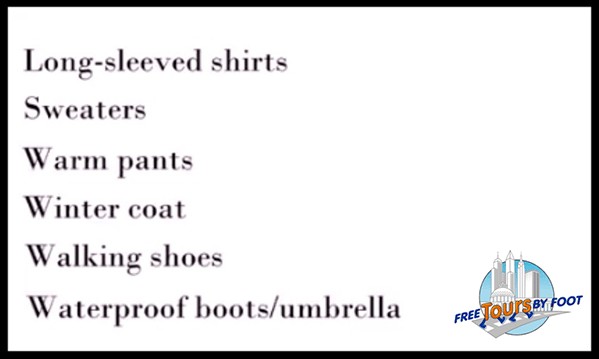This post covers when to expect snow in London and how much snow to expect in any given month.
We also provide tips on things to do and how to dress for the snow and cold.
As a retired meteorologist turned tour guide, I didn't expect that I would use my experience as a forecaster in my new career in tourism.
But here I am, finding myself answering more weather questions as a blogger than I ever did as a weatherman.
So, I decided to use my expertise to answer a recurring question: when does it snow in London, England?
- Overview
- Snowfall by Month
- How to Stay Safe in the Cold and Snow
- What to Wear
- The Impact of Snow or Cold
- Things to Do in the Cold
- London in Any Weather
- When Is the Best Time to Visit?
OVERVIEW
Winters in London are generally cold and often rainy.
The average daily high temperature between December and February is about 48°F (9°C) and the average daily low is 41°F (5°C).
Below-freezing temperatures, however, are not uncommon, and snow is not unheard of.
Accumulating snow/sleet can be expected on only 3-5 days, mostly during the months of December to February.
Fortunately, the snow does not stay on the ground in London very long; most of the time it melts away very quickly.
This is due to the urban heat island effect. It's also why you're more likely to see a bit more accumulation in the suburbs.
To see heavier snow, you'll head up to the Pennines in northern England or to northern Scotland.
In planning your trip, you'll likely want to know whether you need to pack for a major snowfall or just a few snowy days.
Below, we've listed the typical temperatures for the winter months, as well as the average precipitation and average number of snowfall days.
1. Snowfall in November
The average total precipitation during November is 60 mm (2.4 inches).
Rainfalls of at least 1 mm (0.04 inches) can be expected on about 9 days during November.

Snow is reported once every couple of years but does not accumulate on the ground.
Be sure to check out both our full London November weather posts.
2. Snowfall in December
The average total precipitation during December is 55 mm (2.2 inches). December tends to be more winter-like.
Days with at least 1 mm (.04 inches) or more of precipitation average about 9-10.

Some snow falls in December, but only on about 2 days with about 1-day recording snow accumulation.
So, if you are hoping for a white Christmas, chances are you are going to be disappointed.
Be sure to check out our full London December weather post.
3. Snowfall in January
The average total precipitation during January is 55 mm (2.2 inches).
January normally has about 8-9 days with precipitation of at least 1 mm (0.04 inches).

Snow falls on average on about 3 days with accumulating snow on 1-2 days.
Be sure to check out our full London January weather post.
4. Snowfall in February
The average total precipitation during February is 41 mm (1.6 inches).
February sees about 6-7 days with at least 1 mm (0.04 inches) of rainfall.

February is the snowiest month of the year, with 4 days, on average, reporting some snow and 1-2 days with accumulating snow.
Be sure to check out our full London February weather post.
5. Snowfall in March
The average total precipitation during March is 40 mm (1.6 inches).
March sees about 7 days with at least 1 mm (.04 inches) of precipitation.
There is less snowfall this month. It normally occurs only about 1 day but rarely accumulates on the ground.
Be sure to check out our full London March weather post.
6. Snowfall in April
The average total precipitation during April is 44 mm (1.7 inches).
April sees about 6-7 days with at least 1 mm (0.04 inches) of precipitation.
Snow occurs about 1 day on average but rarely accumulates.
Be sure to check out our full London April weather post.
HOW TO STAY SAFE IN THE SNOW AND COLD
For those who haven't grown up in the snow and cold, there are often questions about just how to stay safe in inclement weather.
We have a few tips that should help make your time outside more comfortable and most importantly, safe.
1. Choose Your Clothes Wisely
Perhaps the most obvious suggestion is to wear proper cold-weather attire if you plan to be outdoors.
Layers and water-resistant materials are key to keeping warm.
Layers allow you to pile on or take off clothes, especially as you go in and out of buildings.
Water-resistant materials ensure you don't get wet, one of the worst things that can happen when you are outside as it can lead to hypothermia.
Another tip is to make sure your skin is not exposed to the weather.
You don't want to lose heat that way, and you do want to protect yourself from the damage that deep cold can do.
Finally, be thoughtful about your shoes. Choose function over fashion.
A good set of walking boots and winter socks will keep your feet (and also your body) warm through a day of walking through snow.
And if they have good soles on them, they will go a long way toward preventing you from slipping and falling should it be icy outside.
We've listed some helpful attire below.
2. Choose Food and Drink That Keep Your Body Heat High
Another suggestion is to stay well hydrated with water. It's easy to become dehydrated in the winter, which causes your body temperature to drop.
It's best to keep away from alcoholic or caffeinated beverages. They cause your body to lose heat more quickly because they restrict the blood vessels.
Instead, a good cup of caffeine-free tea, something like apple and cinnamon tea or lemon and ginger tea, will keep you hydrated and keep that blood moving.
Hot chocolate is always a good bet. Some folks suggest warm milk as an option, and broth works well to warm you up from the inside.
Because you don't want to get tired while trudging around in the snow, try to eat foods that give you a boost of energy or at least reduce fatigue. Eggs, cheese, and fish are good for this.
Also, eating beef, pork, or lamb will give you the iron you need to keep your body warm.
3. Keep An Eye Out for Signs of Hypothermia or Frostbite
If you start shivering, be sure to go indoors as soon as possible. Your body is telling you it's losing heat.
Relatedly, pay attention to signs of hypothermia. Shivering is one, but so is confusion, drowsiness, and slurred speech.
Of course, if your extremities start to lose feeling and color, those could be signs of frostbite. Again, get inside as soon as you can.
4. Avoid Ice at All Costs
A little frost on the ground can be expected in the mornings, but when ice appears, it's another story.
It may seem fun to slide across an ice sidewalk, but it can result in an unplanned trip to the A&E for a broken body part.
Also scary and dangerous is trying to drive when it's icy out, especially if you haven't done it before. Even expert drivers have no control when conditions are like this.
Ice can often be hard to spot, especially under snow, so avoiding it at all costs is a good choice.
If you hear reports of icy conditions, it's better to play it safe and stay indoors.
5. Keep Moving
Folks who haven't spent time in the snow or cold may underestimate how quickly your body can become dangerously cold.
One trick to keeping your body warm is to move.
If you're on a walking tour and are cold, feel free to swing your arms and legs about. You can even jump up and down.
Everyone will understand that you are just keeping your blood moving and your body warm.
6. Listen to the Weather Reports
If you are in London, the most accurate forecast can be found at The Met Office.
Check them for weather warnings, temperature, visibility, and other information that will help you decide whether to proceed outdoors.
Other weather apps that are recommended include Accuweather, The Weather Channel, and Radar Scope.
WHAT TO WEAR IN THE COLDER MONTHS
We recommend that, in the colder months, you dress in layers.
A warm outer layer will keep you comfortable outside, while a lighter inner layer ensures you won't be too hot at any indoor attractions.
Read the information above to see the average temperature for the month you are visiting London. The lower the temperature, the heavier the coat.
We write in detail about winter packing on our Winter Packing List, but you can find the highlights for London listed here:
Disclosure: While our recommendations are always unbiased, we may receive a small share of sales through some of the links as an Amazon Affiliate below at no cost to you. See the full text.
1. A Waterproof Jacket
We like anything from Camel Crown.
Their affordable 3-in-1 winter hiking jackets come in men's and women's cuts.
2. Extra Layers
We love down vests and the 32 DEGREES down vest is ultra-lightweight with a flattering fit.
The men's Wantdo Packable vest, also available in jacket style, comes with a pouch for easy packing.
If you'll be spending time outside for stretches of time or really don't like being cold, a great option is base layers.
Merino Wool Base Layer tights, which come in men's and women's styles, are a great option.
3. An Umbrella
An umbrella can be used for protection from precipitation as well as heavy flakes of snow.
We think it's smart to have a small, portable compact umbrella that fits in small bags.
4. Winter Accessories
Be sure to pack some warm wool socks.
A pashmina scarf will keep your throat warm and can be used indoors over your shoulders if you are a bit chilly.
The Achillea Pashmina comes in 45 colors, and you can get a reversible one for more outfits!
And a warm hat and gloves are also a necessity.
5. Extra Warmth
Our biggest tips are always to bring things that serve multiple purposes, and for winter travel, you can't do better than a portable charger.
You never know when you'll find a working and available outlet, so why not find one that does double duty as a hand warmer?
Zippo makes a rechargeable handwarmer that also has a USB port to charge your devices.
Should you forget any of these items, London has no shortage of shopping. Read our post on where to shop in London for some suggestions.
And if you are in London for the holidays, the Christmas markets are an excellent place to pick up gloves, hats, scarves, and the like.
2. Delays, Cancellations, and Closures
The UK transport system was not designed to function when there is heavy snow or extreme weather.
Trains can have difficulty when tracks freeze up causing longer journey times or complete travel disruptions.
Planes may not take off because of issues with icy runways and icy wings or because of visibility issues.
Stores and attractions may close, and tours may be canceled, because it's not safe for staff or clients to be outdoors.
Know that cancellations and closures are happening because experts have deemed it necessary.
Should the worst happen, there will be news reports keeping folks informed about when they expect to have everything up and running again.
3. The Unexpected
One tip I have when traveling is to embrace the unforeseen
If you've planned this trip for a long time and now the weather is impacting it in ways you haven't predicted, allow yourself a moment to be upset and then make a new plan.
Sometimes, when everyone is in the same position, you can make connections and have experiences that you wouldn't have expected.
Maybe you'll end up in a hotel bar full of travelers from around the world, having conversations you would have missed if you were checking off all of your travel to-dos.
Maybe you'll join a snowball fight or help push a bus out of the snow. Maybe you'll build a snowman with locals in Greenwich Park.
Maybe you'll experience the kindness of a London cab driver who makes sure you get back to your accommodations safely.
I've often been surprised that a positive memory has formed when the unplanned has taken place, and I end up being happy to have been allowed that experience.
THINGS TO DO WHEN IT SNOWS IN LONDON
If the weather is not extreme, don't let the snow stop you from enjoying your time in London. It certainly doesn't stop the locals from being out and about!
To help you plan for any inclement weather, we've put together posts on things to do during the months when you might experience some snow.
Be sure to check out our extensive post on what to do in London all year round and on choosing the best time to visit London.
If you are in town in November, December, or January, take a look at our guide to Christmas in London.
Many activities begin in November and remain open into January.
Below are the top things to do in London that are indoors. We also list activities you can only do in the winter months!
1. Go to a Museum or Attraction
London has so many museums, you could spend days visiting them all! Many London museums are free or have free days or hours.
If you are in London for a month when it seems likely you will encounter some bad weather, consider getting a tourist attraction discount pass.
Some museums that do charge an entrance fee are included for free when you purchase a pass.
To help you narrow down your choices, here is a list of some of the top museums and historic attractions:
- The Tate Modern
- The British Museum
- St. Paul’s Cathedral
- Westminster Abbey
- Buckingham Palace
- Tower of London
- Natural History Museum
Keep in mind that these popular museums will be crowded in bad weather.
Going to a lesser-known museum, like a medical museum or military museum might be a good option if you don't like crowds.
2. Take a Bus Tour
London has several hop-on-hop-off bus tours. A bus tour can help you see London and stay dry as you hop from one attraction to another.
Additionally, there are many themed bus tours, such as the Harry Potter Tour, the Jack the Ripper Bus Tour and a ghost ride.
Check out our bus tour comparison post.
3. Join a Free Walking Tour
Believe it or not, our name-your-own-price tours run rain or shine, and yes even snow, provided isn't a storm!
We also offer indoor tours of the British Museum and the National Gallery of Art.
Find out more about our walking tours of London to see what tours we offer.
3. Take an Afternoon Tea
This is just about as British as it gets! Stay cozy while you sip tea and eat scones with jam.
See our post about afternoon tea in London or why not check out the Twinings Tea Shop in the City of London?
4. What to Do at Night in the Cold
You could just stay inside your hotel room and watch the telly.
But why do that when you have so many choices of things to do in London when the weather is bad?
Here are just a few options:
- Watch a West End Musical
- Take a Dinner Cruise on the Thames
- Go on a Pub and Club Crawl
- Visit the Sky Garden Observation Deck
Get even more ideas from our post on things to do at night in London.
5. Embrace the Chilly Weather!
If snow arrives in November or December, it's the perfect time to visit one of the Holiday markets such as the Southbank Center, the Greenwich Christmas Market, or Hyde Park's Winter Wonderland.
You can also:
- Go Ice Skating
- See the Holiday and Christmas Lights
You can find more suggestions on how to spend a snowy or damp day from our post on what to do in London in the rain.
After all, what is snow but a prettier version of rain?
RELATED POSTS:









